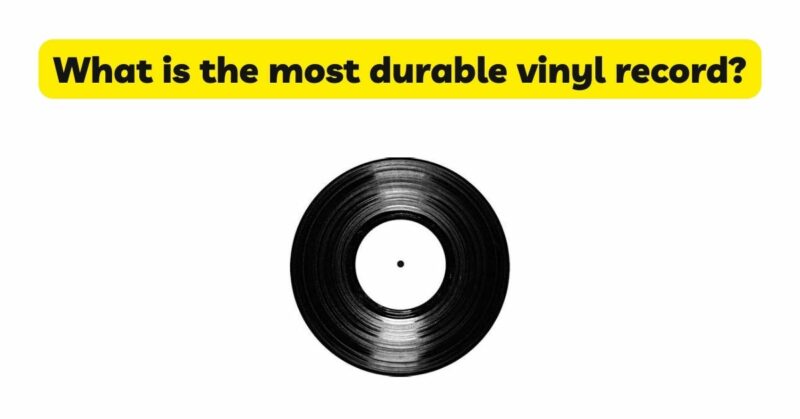Vinyl records have a rich history and continue to captivate music enthusiasts with their tactile and immersive listening experience. When it comes to vinyl’s durability, the lifespan of a record depends on various factors, including the quality of the pressing, the care and handling it receives, and the storage conditions. In this article, we will explore the characteristics that contribute to the durability of vinyl records and highlight some of the most resilient and long-lasting records in the market.
- Vinyl Composition: The composition of the vinyl itself plays a crucial role in a record’s durability. Vinyl records are typically made from polyvinyl chloride (PVC) mixed with additives that enhance their stability and longevity. High-quality vinyl compounds that incorporate durable additives, such as stabilizers and impact modifiers, contribute to the resilience of the record. The use of premium vinyl compounds can result in records that withstand repeated plays and environmental conditions without significant degradation.
- Record Thickness: The thickness of a vinyl record is an important factor in its durability. Thicker records are generally more resistant to warping and less prone to damage caused by handling and playback. Standard vinyl records typically have a thickness ranging from 120 to 180 grams, with 180-gram records being more robust and less prone to warping. However, it’s important to note that thickness alone does not guarantee durability, as other factors such as pressing quality and vinyl composition also influence a record’s longevity.
- Pressing Quality: The quality of the pressing process significantly impacts a record’s durability. A well-pressed vinyl record exhibits consistent thickness, uniform grooves, and proper centering. Records that are pressed with precision and attention to detail are less likely to suffer from issues such as off-center pressings, non-fill (where the grooves are not fully filled with vinyl during pressing), or other manufacturing defects that can affect playback and durability. Records pressed at reputable and experienced pressing plants tend to have higher quality and durability.
- Record Handling and Care: Proper handling and care are essential for maintaining the durability of vinyl records. Mishandling, dropping, or applying excessive pressure on the record surface can lead to scratches, warping, or damage to the grooves. Handling records by the edges and using a clean, non-abrasive cloth to remove dust and debris before each play can help preserve their condition. Additionally, storing records upright in a controlled environment away from extreme temperatures and humidity minimizes the risk of warping and other forms of damage.
- Storage Conditions: The storage conditions in which vinyl records are kept greatly influence their durability. Extreme temperatures, high humidity, and exposure to direct sunlight can warp the vinyl, damage the grooves, and affect the overall integrity of the record. Storing records in an upright position in a cool, dry place away from direct sunlight and fluctuations in temperature is crucial for preserving their durability. Proper inner and outer sleeves made from archival-quality materials can also protect records from dust, moisture, and potential scratches.
- Record Label and Pressing Plant: Certain record labels and pressing plants have earned a reputation for producing high-quality and durable vinyl records. Labels that prioritize quality control and work with experienced pressing plants tend to deliver records that exhibit exceptional durability. Establishing relationships with trusted labels and seeking out records pressed at reputable plants can increase the likelihood of acquiring durable vinyl records.
- Longevity of Vintage Records: While new records can exhibit durability due to advancements in pressing techniques and vinyl formulation, it is worth noting that many vintage records have withstood the test of time and are considered durable. Vinyl records from the 1950s to the 1980s, particularly those produced by reputable labels and pressing plants, continue to be playable and enjoyable decades after their initial release. The longevity of vintage records is a testament to the inherent durability of vinyl when handled and stored properly.
- Resilient Vinyl Formats: Certain vinyl formats have gained recognition for their durability. For example, picture discs, which feature images or artwork embedded between the vinyl layers, are known for their robust construction. Additionally, colored vinyl records, particularly those made from opaque or solid-colored vinyl, tend to exhibit greater resilience compared to translucent or clear vinyl. These formats often incorporate additional additives or materials that enhance their durability.
Conclusion: The durability of a vinyl record depends on multiple factors, including the vinyl composition, pressing quality, handling and care, storage conditions, and the reputation of the label and pressing plant. While specific records cannot be definitively identified as the “most durable,” records made from high-quality vinyl compounds, pressed with precision, and handled and stored properly have a greater likelihood of exhibiting exceptional durability. Vintage records from reputable labels and pressing plants also showcase enduring resilience. By prioritizing quality, careful handling, and proper storage, music enthusiasts can enjoy the longevity and durability of their vinyl records for years to come.


